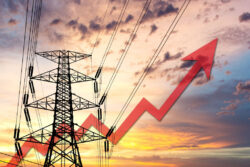It sounds like the panacea of all our troubles. The energy transition promises seemingly free energy. After all, what does the sun and the wind cost us?
And yet, free energy would be a curse. Who would be willing to sell it? And at what price? And who would invest in the production of something that is free?
The point is that it’s rather difficult to figure out how such a system would actually function. But, luckily, nothing in this world is quite free when you take a closer look. And don’t worry your little heads too much. The government is already onto this challenge. So, what could possibly go wrong?
Today, we explore why something will go wrong. Over at our Power Play Summit, which kicks off at 2pm today, energy expert James Allen has already begun laying out how to profit from what will go wrong. Have you signed up yet?
Renewable energy may well be almost free at the margin. Meaning the cost of producing another watt is almost zero. Windmills just stand in the wind, solar panels in the sun, and so on. But there are some other rather important costs that must be paid for instead.
Renewables are incredibly resource intensive to build. They require huge amounts of minerals, metals and other resources.
They use up far more space than their fossil fuel-burning cousins too. Which increases startup costs because land isn’t free.
And, because renewable energy is intermittent, and cannot be controlled or predicted, we need to take various other expensive measures. Storage must be built, a bigger grid must be built to move the power, backup fossil fuel options need to be kept on standby, and we need to increase total capacity to adjust for unreliable production.
But issues like this are quite obvious. Consider something less clear, which I suspect will prove a huge hurdle, or profit centre, for renewables in the future. It’s the nature of these challenges that catches my attention.
The second most important concept in economics, coming in after the issue of “scarcity”, is the idea of marginal analysis. Humans make decisions based on increments, not absolutes. We do not ask, at the outset of a meal, “How many slices of pie should I eat?” We ask, after each one, “should I eat another slice of pie?”
Each additional slice has slightly less benefit and slightly more costs each time. We continue to eat until the cost of another slice outweighs the benefits, in the case of pies, literally.
Fossil fuel energy is all about operating at the margin in much the same way. What is the cost of adding another lump of coal to the furnace? And what is the price of electricity we can sell as a result?
We produce electricity until the two equal each other in order to maximise profits, and thereby supply precisely the right amount of electricity for the economy given the cost of doing so.
The link between marginal cost and marginal benefit has an important effect. It means we don’t produce too much energy because it would impose a loss on those doing it. But we do tend produce enough energy because of the incentive to make a profit.
What keeps supply and demand in line, in other words, is incentives being linked to marginal cost and marginal benefit. When we want more or less energy, the incentive to produce or forgo is constantly rebalancing the system.
More importantly, there is a link between cost and revenue (marginal cost and marginal benefit). They both go up and down together.
Those who decide to produce less also incur less costs as a result, because they use up less coal and the coal not used can be used at a later date. Producing more means higher costs too, because more coal is used.
If energy demand spikes, causing higher prices, then more coal can be used to meet demand.
If energy demand falls, causing lower prices, less coal is used to produce less electricity.
Renewable energy infrastructure upends all this. It changes how marginal change is applied to our electricity system. Because it breaks the links between marginal cost and marginal benefit. Heck, it might even reverse them in some situations. And this will make incentive, and power prices a bit… odd.
As mentioned, there is almost no marginal cost to producing energy for wind and solar. Alost all the cost is upfront in the initial setup.
Indeed, producing less energy can impose a higher cost, because the windmill owners must be paid to stop them from providing power. The Telegraph reported in January that, “Turbine operators receive £65000 to stop powering homes on Tuesday amid concerns over Britain’s strained energy supply.”
This may or may not make sense. But the point is that it upends the links between marginal cost and benefit which is used to find an equilibrium power price which balances supply and demand.
If wind farm owners can get paid money for not producing power, what is the incentive you create? And does that incentive make the problem of oversupply in the wrong places better or worse?
Because the link between marginal cost and marginal benefit is broken under renewables, the system’s natural tendency to balance supply and demand becomes unstable.
One key risk is that of a sunk cost – a wind or solar farm which produces unneeded energy and which pushes the price of energy so low it even goes negative. This is already a problem with renewables as a small part of our grid.
Another risk is that of an energy shortfall. The proposed solution to which, strangely enough, is to produce more renewable energy. But that only worsens the risk of sunk costs during times when the sun is shining and the wind is blowing too much.
So, all these marginal price issues mean we have no obvious way of pricing power in an energy transition that aligns incentives with supply and demand. The solution is, of course, a government programme of subsidies and controlled prices, often in long-term contracts. What could possibly go wrong?
A lot, it turns out. In its article “Why Britain is suddenly blowing cold on a wind power revolution”, the Telegraph explains that the pricing mechanisms for wind farms has fallen flat, undermining investment in wind farms and making projects uneconomical. One City analyst warned, “You cannot build an energy system if nobody makes a return in doing so.” Not so long ago, we were talking about windfall profit taxes. Now nobody is making money?
Perhaps this is why GE’s renewable energy business made a $2.2 billion loss in 2022, Denmark’s Orsted had to write down the value of its biggest offshore wind project in the US, offshore wind turbine maker Siemens Gamesa made a huge half-a-billion-dollar loss, wind turbine maker Vestas made a loss of €1.7 billion, and so on.
What happens to a grid where renewables providers are paid money to produce electricity on long-term contracts when it is already in oversupply and priced negatively on the markets?
I haven’t got a clue. But it’s going to be weird.
In the end, an entire energy system must be kept ready to jump in when renewables fail. The UK had this in March 2023, when it returned to coal. The Germans kept their fossil fuel system in backup too and needed it in the winter of 2022/23.
In the future, that backup system will supposedly be energy storage. But I seriously doubt we can even build enough energy storage to keep pace with the electrification of the fossil fuel economy, let alone meeting the demands of the existing electricity grid.
What does all this mean for the UK? I think it means 2022’s energy crisis was just the beginning. We launched into a renewables revolution that is wreaking havoc on our energy systems that are not built for renewables. And that havoc is showing up in a long list of surprising ways. The potential for surprising unintended consequences abound, as we saw with the coal price in 2022.
That’s why we have launched our Power Play Summit now. To help you reap the energy sector profits which 2022 were merely an appetiser of.
Which is quite a claim given the dramatic outperformance of energy stocks last year. In the first six months of the year, 19 of the top 20 performers in the US’ S&P 500 index were connected to fossil fuels. The UK’s FTSE 100 outperformed global peers in 2022, thanks to its heavy weighting towards oil and miners. Australia’s coal stocks were the best performers for the year on that market as the world’s foremost clean energy virtue signallers, Germany, went back to coal.
If all this plays out again over longer timeframes in the future, investors can expect to profit again.
The Power Play Summit will show them how.
The answer is of course the best form of energy when it comes to marginal management. The easiest to control, the fastest to bring online and thereby the most profitable opportunity out there. Find out what it is, from James now.

Nick Hubble
Editor, Fortune & Freedom



